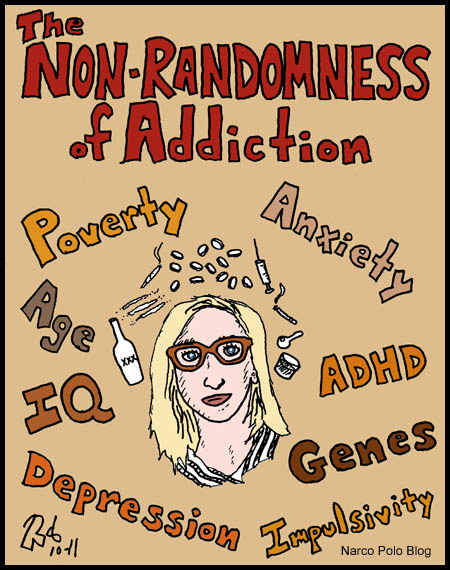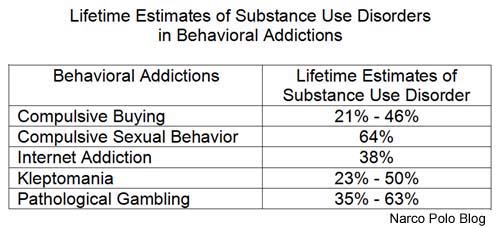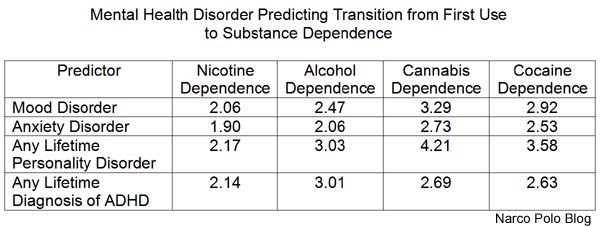
A tenet of the drug war is that drug X is so pleasurable that once tried, most people cannot resist it. There is no way of knowing if you have the “disease” of lifelong addiction to drug X, therefore no one should ever try drug X. All of this is wrong.
The vast majority of people who try drugs do not go on to become addicted (1, 9), and those that do tend to share certain characteristics and conditions. Here are some of the things that predispose people to addiction:
Other Addictions
If a person has not been able to exercise self-control with one source of pleasure, it is more likely he or she will not be able to exercise self-control with another source of pleasure. As can be seen in the following chart, someone diagnosed with a cocaine dependence is 6.64 times more likely than someone without a cocaine dependence to develop a dependence to alcohol.
 (6)
(6)
This overindulgence is not reserved to drugs as demonstrated by the considerable overlap of drug addictions and behavioral addictions. Note that the percentage of the general population that has ever experienced substance use disorders is 14.6%. (5)
 (2)
(2)
Although overlap with food addiction is complicated by drugs’ effects on weight (e.g. cigarettes and stimulants suppress appetites), 32.6% of weight-loss surgery candidates have experienced substance use disorders. (4)
Poverty
Surveys of drinking have long found that despite being more likely to abstain, those from lower socioeconomic groups are still “much more often” problem drinkers. (10, p. 160) A more recent study has found income serves as a predictor for more than just alcohol dependence. As seen below, people in the poorest income bracket are almost three times as likely to become dependent on cocaine as those in the wealthiest bracket.
 (6)
(6)
Mental Health Issues
People with mental health issues are more likely than their peers to become addicted to substances. As can be seen below those diagnosed with ADHD or a personality disorder are three times as likely to become dependent on alcohol.
 (6)
(6)
Lower Intelligence
Heavy drug users frequently score lower on cognitive tests than their peers. This has been used to say drugs lower intelligence. In the early 2000s two twin studies disproved this idea. In these studies one twin had a history of drug abuse and the other did not. Neither study found a correlation between cognitive performance and amount of drug use. The studied drugs were marijuana, cocaine, and amphetamine. Lower cognitive abilities lead to heavy drug use, not vice versa. (3, pp. 150-152)
Genes
An adoption study has shown that the biological father’s drinking patterns predict a son’s alcoholism, while the adoptive father’s does not. Boys whose biological fathers were severe alcoholics had an alcoholism rate of 18% with an alcoholic adoptive father, 17% with an adoptive home free of parental alcoholism. A study of twins found shared genes did not correlate with experimentation with illicit drugs, but if an identical twin was dependent there was a 40% chance the twin was also dependent. (3, p. 92)
Addictive Personality
People with substance use disorders, just like people with behavioral addictions, score high on self-report measures for sensation-seeking and impulsivity, and low for harm avoidance. (2) This is not surprising. An addict is arguably someone who chooses the sensation an activity provides at levels that are harmful. The choice is influenced by his or her impulsivity, i.e. the tendency to act without weighing the future consequences of one’s actions. The pleasure an addictive behavior provides is immediate whereas the pleasure of moderation is often distant and abstract (e.g. long-term health, more stable work/family life).
Youth
Not only are older people much less likely to become dependent on something, they are also more likely to end dependencies. The vast majority of addicts “mature out” of their addictions and most of them accomplish this without treatment. (11, p. 13) Maturing out is so pervasive that a national 2010 survey found that only .1% of people 65 or older had abused or been dependent on an illegal substance in the past year. The highest level was reached by 19-year-olds (9.3%) from which the number decreased with each ensuing age category. (8)
 (6)
(6)
In line with this, addictive personalities weaken over time. Older adults report being less impulsive, sensation-seeking, and risk tolerant than their younger peers. (12)
Conclusion
Addiction is an intense involvement people fall into for solace when they cannot find better gratifications in the rest of their lives. (11, p. 16) The escape provided by destructive behaviors is usually only appealing to those suffering from internal sources, e.g. mental health issues, or external sources, e.g. poverty. Addiction is a symptom of underlying problems. This helps explain why, contrary to the exhortations of America’s drug warriors, the legal status of drugs has been found to have “surprisingly little measurable consequence” on factors like addiction rates. (7, 3, p. 3) The locus of addiction lies in people, not substances.
Sources
1. Robert Arthur, You Will Die: The Burden of Modern Taboos, 3rd Ed. (2008), p. 330.
2. Jon Grant, et al., “Introduction to Behavioral Addictions,” American Journal of Drug and Alcohol Abuse, 36, 2010.
3. Gene Heyman, Addiction: A Disorder of Choice (2009).
4. Melissa Kalarchian, et al., “Psychiatric Disorders Among Bariatric Surgery Candidates,” American Journal of Psychiatry, Feb. 2007. LINK
5. Ronald Kessler, et al., “Lifetime Prevalence and Age-of-Onset Distributions of DSM-IV Disorders in the National Comorbidity Survey Replication,” Archives of General Psychiatry, 62, 2005.
6. Catalina Lopez-Quintero, et al., “Probability and Predictors of Transition from First Use to Dependence ….,” Drug and Alcohol Dependence, 115, 2011.
7. Robert MacCoun and Peter Reuter, Drug War Heresies (2001), pp. 236-237.
8. “National Survey on Drug Use and Health,” Fig. 5.3B, Substance Abuse and Mental Health Services Administration (SAMHSA), 2010. LINK
9. Frank Owen, No Speed Limit (2007), p. 48.
10. Stanton Peele, Diseasing of America (1995), p. 160.
11. Stanton Peele, Seven Tools to Beat Addiction (2004).
12. D.R. Roalf, et al., “Risk, Reward, and Economic Decision Making in Aging,” Journals of Gerontology, 6 Sep. 2011. LINK
No comments:
Post a Comment